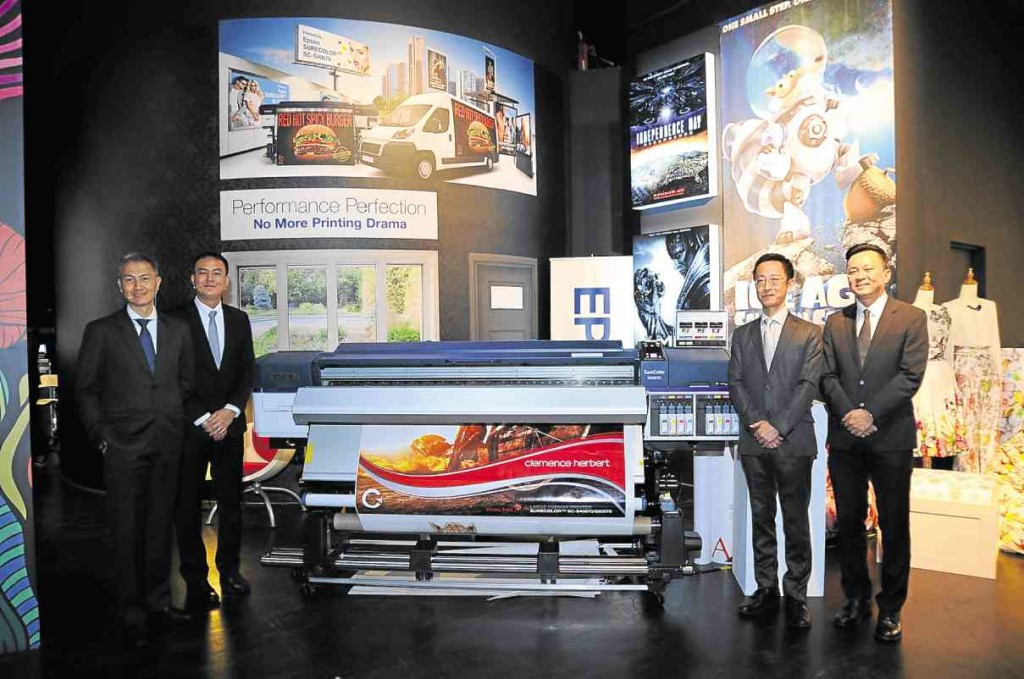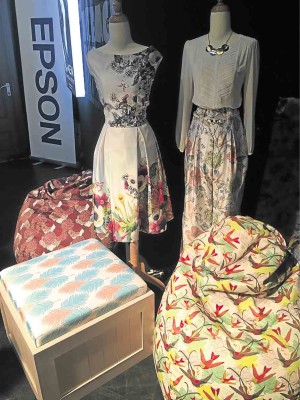Print’s not dead, says technology giant Epson

EPSON regional manager Shaun See (left), Epson regional product manager Yap Beng Tiek, Epson Malaysia country manager Shimizu Tomoya and Epson Malaysia general manager for sales and marketing Danny Lee showcase the new SureColor S-series printer
The world has seen economic meltdowns over the past few years, but the gloom and doom uttered by naysayers should not be enough to strip the environment of its colors.
Posters, billboards and building facades continue to bring the eyeballs toward establishments, thanks to Instagram-worthy filters and palettes churned out by one of the most used, yet underrated machines in the last few decades—the printer.
“There’s always a need for printing,” said Pamela L. Albar, Epson Philippines Corp. commercial and industrial department head. She said the printing industry is the least affected when the economy is down, since businesses still need to attract customers through ads.
But with an economy primed to scale new heights in the next few years, the Philippines will likely prove to be one of the best clients for the Japanese technology giant.
At the launch of the company’s SureColor S-series high-speed large format printers in Kuala Lumpur last March 10, Epson Singapore Pte Ltd general manager for commercial and industrial printers Shaun See said the company was targeting to grow its business in the Philippines by 18 to 22 percent this coming fiscal year beginning April.
“I believe the Philippine team could do it. The markets are there. The Philippines is one of the most stable economies in the region,” he said.
On the sidelines of the event, See noted that the textile and garment segment of the business was driving the company’s growth in the country.
“It’s really the textile [printer] business that’s surpassing all expectations. We’re just slow to adapt to developments in the textile digital space, but compared to other segments, textile [printers] is a fast growing business,” added Albar, noting that sales for this segment grew by 20 percent in fiscal year 2015.
The Philippines is no stranger to the textile and garment industry. Textile mills flourished in the 1960s, only to be forcibly shut down by the rise of cheaper apparel from China in the decades thereafter.
But the changing tastes in the interior design and fashion design industries have made “printed” textiles in vogue again.
During the Epson event, art patterns were printed onto yards and yards of white cloth. RTW pieces stood as background, displaying colorful and fashionable prints.
In the Philippines, the entry of printed clothing came with the change in lifestyles, said See. Sports apparel now bear “printed” rather than embroidered logos, which are more likely prone to wear and tear.
“We have seen a lot of locals using our technologies for export purposes. One of our customers is an ex-athlete, but now he’s producing garments for frisbee teams in the United States,” he said. “The Philippine market is also getting more affluent. They want more personalized things, to be able to display their identities.”
These changing lifestyles have made the country one of Epson’s best clients when it comes to textile printers.
“In Singapore, we see a flat growth [for overall business] because they don’t have a textile industry. Plus, everything’s not working in their favor. The industry in Malaysia, on the other hand, is not as big as that of the Philippines,” he said.
It helps that Epson is big on research. It coughs up $1.5 million daily, creating patent after patent to come up with latest printer technologies.
Besides developing direct-to-garment technologies for its textile segment, the firm is also creating machines fast enough and eco-friendly enough to suit the needs of establishments in need of advertising displays.
Developed over a four-year period, Epson’s new Sure-Color S-series printers launched last month were designed for high-speed printing.
Imagine a bond paper coughed up fast enough by your personal printer, except that this 64-inch printer produces large movie posters.
The printers also use eco-solvent, yet durable inks—the fourth generation Epson Ultrachrome GS3 inks.
Priced between $16,995 and $24,995, the S-series is a “straight up investment” for businesses in need of a well-oiled machine “like a guy running a marathon every day,” said See.
He added that Epson sees the signage segment of business growing by 20 percent in the region because of these new printers.
The firm is also anchoring its growth on this segment as “we see a migration to outsource printing, which is now happening in the Asian region,” said See.
Big businesses such as food companies are not the only ones buying these big printers, but also smaller businesses tapped by firms with large printing needs (billboards, posters, ads plastered on the body of a bus, elevator, wall, etc.)
Albar said Epson was a little late in the signage printing segment in the Philippines, “but hopefully, this new signage printers will actually spurt more growth for Epson.”

